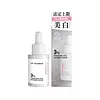What's inside
What's inside
 Key Ingredients
Key Ingredients

 Benefits
Benefits

 Ingredients Side-by-side
Ingredients Side-by-side

Water
Skin ConditioningDipropylene Glycol
HumectantTranexamic Acid
AstringentCurcuma Longa Root Extract
MaskingButylene Glycol
HumectantHydroxyacetophenone
AntioxidantSodium Citrate
BufferingGlycerin
HumectantBetaine
HumectantPEG/PPG/Polybutylene Glycol-8/5/3 Glycerin
HumectantSphingomonas Ferment Extract
Skin ConditioningPhenoxyethanol
PreservativeHydroxyethyl Acrylate/Sodium Acryloyldimethyl Taurate Copolymer
Emulsion StabilisingLactobacillus
Skin ConditioningCitric Acid
BufferingXanthan Gum
EmulsifyingTrisodium Ethylenediamine Disuccinate
Citrus Reticulata Peel Extract
Skin ConditioningSorbitan Caprylate
EmulsifyingSodium Hyaluronate
HumectantGlycyrrhiza Glabra Root Extract
BleachingMarrubium Vulgare Flower/Leaf/Stem Extract
MaskingPotassium Sorbate
PreservativeSodium Benzoate
MaskingWater, Dipropylene Glycol, Tranexamic Acid, Curcuma Longa Root Extract, Butylene Glycol, Hydroxyacetophenone, Sodium Citrate, Glycerin, Betaine, PEG/PPG/Polybutylene Glycol-8/5/3 Glycerin, Sphingomonas Ferment Extract, Phenoxyethanol, Hydroxyethyl Acrylate/Sodium Acryloyldimethyl Taurate Copolymer, Lactobacillus, Citric Acid, Xanthan Gum, Trisodium Ethylenediamine Disuccinate, Citrus Reticulata Peel Extract, Sorbitan Caprylate, Sodium Hyaluronate, Glycyrrhiza Glabra Root Extract, Marrubium Vulgare Flower/Leaf/Stem Extract, Potassium Sorbate, Sodium Benzoate
Aloe Barbadensis Leaf
MaskingTranexamic Acid
AstringentNiacinamide
SmoothingGlycereth-26
HumectantBetaine
HumectantPropanediol
Solvent1,2-Hexanediol
Skin ConditioningSodium Hyaluronate
HumectantAllantoin
Skin ConditioningXanthan Gum
EmulsifyingCitric Acid
BufferingCamellia Sinensis Leaf
PerfumingSambucus Nigra Flower
Skin ConditioningMomordica Charantia Fruit Extract
Skin ConditioningLeontopodium Alpinum Callus Lysate
Skin Conditioning
 Reviews
Reviews

Ingredients Explained
These ingredients are found in both products.
Ingredients higher up in an ingredient list are typically present in a larger amount.
Betaine is a common humectant (a substance that promotes retention of moisture). It's known to be gentle on the skin and can help balance hydration.
This ingredient is best for improving hydration and soothing irritated skin. Studies also show it helps even out skin tone.
Fun fact: Betaine is naturally created in the skin and body. The kind found within cosmetic products can be either plant-derived or synthetic.
Another name for betaine is trimethylglycine.
Learn more about BetaineCitric Acid is an alpha hydroxy acid (AHA) naturally found in citrus fruits like oranges, lemons, and limes.
Like other AHAs, citric acid can exfoliate skin by breaking down the bonds that hold dead skin cells together. This helps reveal smoother and brighter skin underneath.
However, this exfoliating effect only happens at high concentrations (20%) which can be hard to find in cosmetic products.
Due to this, citric acid is usually included in small amounts as a pH adjuster. This helps keep products slightly more acidic and compatible with skin's natural pH.
In skincare formulas, citric acid can:
While it can provide some skin benefits, research shows lactic acid and glycolic acid are generally more effective and less irritating exfoliants.
Most citric acid used in skincare today is made by fermenting sugars (usually from molasses). This synthetic version is identical to the natural citrus form but easier to stabilize and use in formulations.
Read more about some other popular AHA's here:
Learn more about Citric AcidSodium Hyaluronate is hyaluronic acid's salt form. It is commonly derived from the sodium salt of hyaluronic acid.
Like hyaluronic acid, it is great at holding water and acts as a humectant. This makes it a great skin hydrating ingredient.
Sodium Hyaluronate is naturally occurring in our bodies and is mostly found in eye fluid and joints.
These are some other common types of Hyaluronic Acid:
Learn more about Sodium HyaluronateTranexamic Acid is best used for treating hyperpigmentation, discoloration, and melasma. It can also help build a stronger skin barrier.
Once applied, Tranexamic Acid starts decreasing inflammation from UV exposure. Tranexamic Acid also prevents our skin cells from meeting the pigment production cells.
Its brightening property makes it great at reducing the appearance of acne scars and marks.
Fun fact: Tranexamic Acid is also a medication used to reduce heavy bleeding.
This acid is derived from lysine, an amino acid.
Learn more about Tranexamic AcidXanthan gum is used as a stabilizer and thickener within cosmetic products. It helps give products a sticky, thick feeling - preventing them from being too runny.
On the technical side of things, xanthan gum is a polysaccharide - a combination consisting of multiple sugar molecules bonded together.
Xanthan gum is a pretty common and great ingredient. It is a natural, non-toxic, non-irritating ingredient that is also commonly used in food products.
Learn more about Xanthan Gum